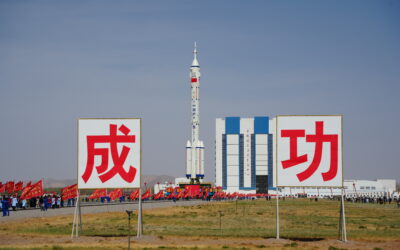
The Long Arm of China’s Security Services
SUBSCRIBER+ EXCLUSIVE REPORTING — When Chinese President Xi Jinping came to San Francisco last November to meet with President Joe Biden, Chinese pro-democracy activists in […] More
While the topic of supply chains may not be cutting-edge or of high public interest, it is no less important to national security than destroying ISIS or having credible immigration policies. On every laptop, unseen and unnoticed, is a remarkable meshing of engineering from the lightning-fast processors and flash memory to the solid-state drive, the screen, and everything in between. What few pay attention to is the engineering within – none of which would be possible without metals known as rare earth elements (REE). The benefits of REE are shared by all electronics, and these devices’ ability to connect with the outside world depends on REE. An example of a broadly used atomically “heavy” REE is dysprosium, which is used to produce small permanent magnets in computers, servers, engines, etc. These components have become indispensable in today’s modern lifestyle. It turns out that similar components have become equally indispensable to our military. From engines, night-vision devices, radar systems, and missile and weapons guidance systems to communications – the list goes on and on – REE are critical to today’s national defense and even more so for tomorrow’s. A good example is the F-35 aircraft. The estimate of REE in the F-35 is over half a ton, distributed in minute amounts throughout the entire aircraft. Other examples are modern Navy ships, which use about two tons, and submarines, which use nearly four tons of these precious metals.
Given the extreme conductivity and optical characteristics associated with REE metals, they are strategic and critical to our national defense. Our dependence, plus the complexity in extraction and processing of the refined REE metals, is the bad news.
The good news is that REE are hardly “rare,” with significant occurrences close to home in Alaska and Canada. These elements include 17 metals found distributed throughout the world. The global quantity is quite substantial; some geologists even estimate REE metals are as common as copper, zinc or nickel. Therefore, it seems that REE metals are called “rare” not because they are rarely found, but because their concentrations in the earth are so low that they are difficult to “upstream,” or mine, and they are exceptionally difficult to “downstream,” meaning process. Downstream requires more than 28 acid-based washing and floatation steps to remove radioactive uranium and thorium. Thus, REE metals are easy to find, but it is extremely challenging to transform the ore into a traditional and useful metallic form. Both the upstream and downstream processes are expensive and produce by-products toxic to our environment.
It is common sense to conclude that if national security is so critically dependent upon the availability of REE, it would be in the best interests of the United States to have control over an uninterrupted supply. With sufficient quantities of REE within the United States, our supply into the future should be fairly well-guaranteed, right? The answer, unfortunately is a qualified “no.” Before the 1990s, the answer would have been an unqualified “yes.” Several decades ago the United States had large mines in California and Alaska, and had a dominant position in the global REE market.
Today, the United States has no REE mining, and the Chinese control over 97 percent of the global supply. The history of how we arrived to this U.S.-China role inversion is too complicated for this article, but is the consequence of strict environmental controls on the mining industry in contrast with none in China, a lack of concern by the Department of Defense, which believed it could buy REE from allied-nation suppliers or reconstitute the U.S. mining capability, and a concerted effort by the Chinese to underbid the price of REE in order to destroy the U.S. REE mining sector through illegal dumping and price fixing. China’s 30-year strategic material supply-chain security plan has been aimed not only at controlling China’s domestic REE supplies flowing to the United States, Japan and Western markets, but equally important, to the acquisition and control of significant REE deposits around the globe as well. From the Chinese perspective, control of the REE market is not just good business, it’s good national defense.
Hypothetically, there would be more than a modest amount of irony if the United States were to go to war with China, deploying the F-35, in which the majority of that half-ton of REE would have been purchased from the supply chain network of the very adversary it is fighting.
While the Pentagon’s senior leadership showed an intentional disinterest in maintaining a credible and uninterruptible REE supply chain, an endless stream of documents flowed from the national security policy community, including think tanks, leading mining engineering universities, the Congressional Research Service, and the Government Accountability Office, all issuing warning after warning that our access to REE was no longer dependable and this had strategic national security consequences. Those warnings fell on deaf ears and thus today, much of the REE in the F-35, and many other systems, has been purchased by way of Pentagon waivers allowing the U.S. defense industry to acquire the REE from foreign and in some cases, generally, prohibited sources.
Issues surrounding REE could also figure prominently in another issue, which is more contemporary but also involves China. Some experts believe North Korea is sitting on REE ore deposits estimated to be over 20 million tons. Should there be regime change in North Korea, China will want to control the future development and processing of these North Korean REE reserves, to keep the West away, and preserve their control of the REE market. There is some evidence to believe China may have already taken the first step when a private equity firm formed a joint venture to develop a multi-billion dollar REE processing plant.
The solution is simple: eliminate U.S. dependency on foreign, especially Chinese, sources of REE. The path to the solution, however, is neither simple nor quick, but experts believe a solution is possible if there is commitment to seeking it. Like any solution, it requires leadership. The Trump Administration and Congress may represent an opportunity to forge a private-academic-public effort to break the several decades-old Chinese lock. The way forward should consist of legislation to trigger the rebuilding of the U.S domestic production capability and leading mining universities and schools to find new deposits for this capability, stockpiling REE, and developing cheaper and more efficient ways to recycle the REE in discarded electronic products. The solution isn’t rocket science, but it does involve using mining and geology science to make the United States safer in the future.
Related Articles

SUBSCRIBER+ EXCLUSIVE REPORTING — When Chinese President Xi Jinping came to San Francisco last November to meet with President Joe Biden, Chinese pro-democracy activists in […] More

SUBSCRIBER+EXCLUSIVE EXPERT PERSPECTIVE — More than two years after its withdrawal from Afghanistan, the U.S. still does not have a clear way forward in the […] More

SUBSCRIBER+ EXCLUSIVE REPORTING — Ukrainians greeted Saturday’s long-awaited House passage of $60.8 billion in aid with justifiable jubilation. For months, their soldiers, civilians, and political […] More

SUBSCRIBER+ EXCLUSIVE REPORTING — A race for control of space is underway, and just as on earth, the U.S. and China are the top competitors. […] More

SUBSCRIBER+ EXCLUSIVE REPORTING — For nearly a week, the Middle East and much of the world were on a knife’s edge, waiting for a promised […] More

BOTTOM LINE UP FRONT – Less than one week after Iran’s attack against Israel, Israel struck Iran early on Friday, hitting a military air base […] More
Search